Understanding Toxic Plants That Endanger Horses
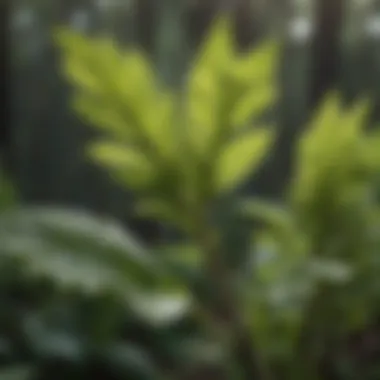

Intro
Horses are magnificent creatures but can be vulnerable to their environment. Some plants found in pastures, gardens, and wooded areas are toxic to equines. Understanding the types of plants that exist in these settings is crucial. This article will delve into the various toxic plants that threaten horse health, provide methods for identifying them, and suggest ways to create safer environments for these animals.
Recognizing the significance of the relationship between horses and their surroundings is essential. This involves not only appreciating the beauty of nature but also being fully aware of the potential dangers that lurk within it. Learning about toxic plants helps owners and caregivers make informed decisions, ultimately contributing to the well-being of horses.
Understanding Woodland Ecosystems
Importance of Biodiversity in Forests
Woodland ecosystems are complex and diverse, housing a multitude of plant and animal species. This biodiversity is vital for several reasons. Firstly, a range of species can contribute to the overall health of an ecosystem. Diverse plant life can support various herbivores and predators, creating a balanced food web. When it comes to horses, these ecosystems offer essential resources such as shade, shelter, and forage. However, some plants within these ecosystems can pose serious threats.
Role of Forests in Climate Regulation
Forests play a significant role in regulating climate. They absorb carbon dioxide and produce oxygen, which is crucial for all living organisms. Additionally, forests help maintain water cycles and contribute to local weather patterns. However, certain toxic plants within these areas can affect the health of horses if consumed. Understanding how to differentiate beneficial plants from potentially harmful ones is vital for anyone involved in equine care.
Identifying Toxic Plants
Identifying toxic plants is the first step in preventing poisoning. Common toxic plants include:
- Yew: Highly toxic, especially the leaves and seeds.
- Hemlock: Notable for its umbrella-shaped flowers, it is extremely poisonous.
- Buttercups: Although they may be common, they can cause irritation and toxicity when consumed in large amounts.
It is important for horse owners to regularly monitor their pastures and wooded areas. Familiarity with the flora in their environment can help them protect their horses.
Effects of Toxic Plants on Equine Health
The impact of ingesting toxic plants can vary from mild to severe. Symptoms of poisoning may include:
- Digestive upset: Colic or diarrhea.
- Neurological effects: Tremors or disorientation.
- Respiratory distress.
In severe cases, toxicity can lead to death. Therefore, being able to recognize these symptoms promptly is essential for any horse owner.
Prevention Strategies
Preventing exposure to toxic plants involves careful management of horse environments. Here are some strategies:
- Regularly inspect pastures for toxic plants and remove them if found.
- Educate yourself and staff about commonly found toxic species.
- Create a safe area for horses away from potentially hazardous plants.
By establishing an understanding of local plant life, equestrians can significantly minimize risks and ensure their horses' safety.
"Awareness is the first step toward prevention. Knowing what plants are harmful is key for horse health."
By addressing these issues, you contribute not only to the welfare of your horses but also to the overall health of the woodland ecosystems in which they reside. Staying informed and diligent can create a safer and more enjoyable experience in nature.
Intro to Toxic Plants
The presence of toxic plants in environments where horses live and graze can pose significant risks to their health and safety. Understanding toxic plants is vital for horse owners, equestrians, and anyone involved in equine care. This section addresses the danger that toxic plants present and underlines the need for awareness and education regarding these potential threats.
The Importance of Plant Awareness
Awareness of toxic plants is essential for several reasons. Horses have a natural drive to graze, which makes them susceptible to exposure to harmful vegetation. If owners can identify and eliminate toxic plants from pastures, they can significantly reduce the risk of poisoning. Knowing which plants can be harmful allows for better pasture management, ensuring that horses have access to safe grazing options.
Additionally, an informed horse owner can create a more secure and enriching environment for their animals. Understanding plant toxicity contributes to overall equine welfare. Informed decisions can be made about land use and pasture development, aligning both the health of the horses and the ecosystem.
Common Myths About Plant Toxicity
Many misconceptions exist regarding the toxicity of plants to horses. One common myth is that all plants are safe for consumption if a horse is not immediately affected. This belief can lead to negligence where certain plants are not removed or monitored. Another myth is that only specific, well-known plants are toxic. In reality, many common species can be harmful, and some may appear harmless while being dangerous.
Furthermore, there is a notion that toxicity levels in plants do not vary. In truth, various factors influence the toxicity of a plant including the plant's maturity, the time of year, and the overall health of the horse.
"Educating horse owners about toxic plants can drastically improve the safety and well-being of their animals."
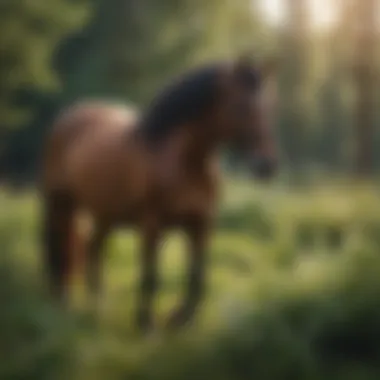
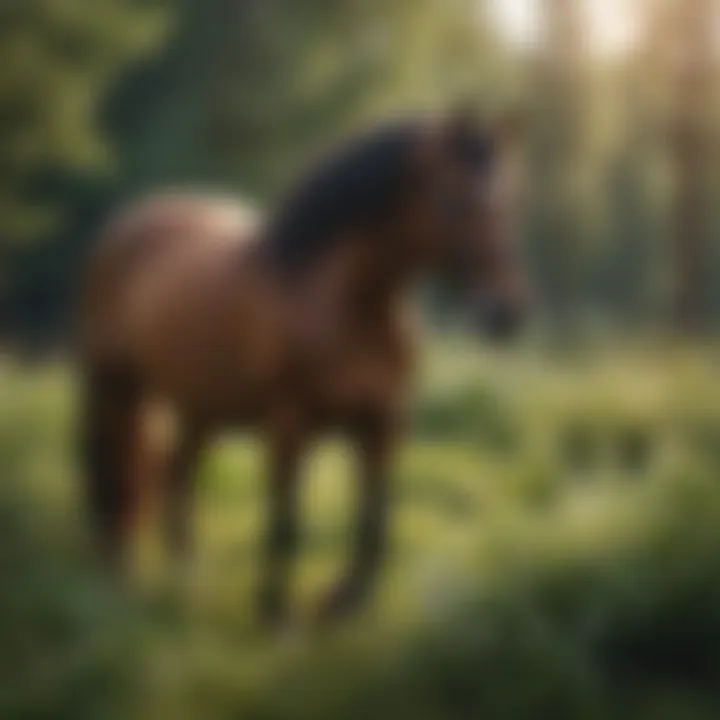
By confronting these myths with factual information, owners can foster a more proactive approach. Seeking knowledge about toxic plants can help mitigate risks effectively. Engaging with resources like field guides or databases can aid in identifying plants and understanding their effects on health.
Characteristics of Toxic Plants
Understanding the characteristics of toxic plants is essential for anyone involved with horses. This knowledge allows horse owners and caretakers to make informed decisions regarding the environments in which their animals live and graze. Recognizing plants that are potentially harmful is a crucial part of ensuring equine health. With a solid grasp of these traits, horse owners can minimize the risk of poisoning and promote safer pasture management.
General Traits of Toxic Plants
Toxic plants often share a set of common traits that can help with identification. Firstly, many of them emit distinctive odors. While not all toxic plants have a strong smell, several do, which could signal their harmful nature. Additionally, the presence of specific colors or patterns on leaves can indicate toxicity. For instance, plants like Foxglove have vibrant flowers and unique leaf shapes that stand out in a pasture.
Moreover, some toxic plants contain specific alkaloids or glycosides that are inherently harmful. This biochemical composition often correlates with the physical traits of the plant itself. Many species known to be toxic can be identified by their size and growth habits, such as being taller or bushier than non-toxic counterparts in the same environment. Educating oneself on these characteristics can facilitate recognition.
Variability in Toxicity Levels
The toxicity of plants can vary significantly, influenced by several factors. Not every part of a toxic plant is harmful. For example, some species, such as Yew, have lethal concentrations in specific parts, like the leaves and seeds, while others may be harmless when consumed in small amounts. This complexity adds to the challenge of identifying the risks associated with various plants.
Furthermore, environmental conditions affect toxicity levels. Factors like soil quality, growing conditions, and even time of year can influence how toxic a plant is at any given moment. Horses may be more susceptible during periods of stress or illness, making it crucial for owners to remain vigilant regardless of a plant's general toxicity. By understanding these variations, horse owners can better protect their animals from potentially deadly ingestions.
"Knowledge is the first step in preventing equine poisoning. Recognize the plants and respect their impacts."
In summary, understanding the characteristics of toxic plants aids significantly in promoting horse safety. This knowledge enables owners not only to recognize these plants but also to gauge the level of threat they may pose based on environmental factors and plant anatomy.
Common Toxic Plants for Horses
Understanding common toxic plants for horses is vital for ensuring the safety and health of equine companions. The presence of these plants can pose serious risks, leading to severe health issues or even death in horses. Recognizing harmful flora is essential for horse owners, as this knowledge aids in creating a safe environment for horses. Furthermore, being aware of these toxic plants helps in preventing accidental poisoning and facilitates prompt medical intervention when necessary.
Toxicity of Common Plants
Yew
Yew is a significant toxic plant, especially for horses. It contains alkaloids that can cause severe gastrointestinal distress and cardiac issues. This plant is often found in gardens and landscapes. Horses are particularly sensitive to yew, making awareness of its presence a priority. The leaves of yew can be mistaken for other harmless species, which adds to the risk. Understanding this plant can help in effective pasture management and safer grazing conditions.
Black Walnut
Black Walnut is another plant that horse owners should monitor closely. Its shavings are often used in bedding, but even small amounts can lead to laminitis, a painful hoof condition. This plant releases toxins into the surrounding area, affecting nearby horses. Recognizing the key traits of Black Walnut trees, such as their distinctive dark bark and compound leaves, is vital for prevention. Awareness can prevent unintentional exposure and protect equine health.
Red Maple
Red Maple leaves are also highly toxic to horses, especially when wilted. Ingesting these leaves can lead to hemolytic anemia, causing weakness and lethargy. The red-hued foliage of this tree can be visually appealing, but horse owners must check for fallen leaves in grazing areas. Understanding how to identify Red Maple trees and manage the risks associated with them is crucial for keeping horses healthy and safe.
Less Known Toxic Species
Bracken Fern
Bracken Fern is often overlooked, yet it poses significant risks to horses. This fern contains compounds that can cause digestive issues and long-term health effects, including cancer. However, in small amounts, horses may consume it without immediate symptoms, leading to a false sense of security. The challenge lies in its disguise – it often blends into natural pastures. Being aware of Bracken Fern's growth conditions can help in recognizing and managing this toxic plant effectively.
Foxglove
Foxglove is known for its attractive flowers, but its toxicity is substantial. The plant contains cardiac glycosides that can lead to serious heart complications in horses. Initially considered a decorative plant, it can find its way into pastures, exposing horses to danger. Knowing how to identify Foxglove based on its flowering patterns is essential for preventing accidental ingestion. This awareness is crucial for horse owners and equestrians in promoting safer environments.
Ragwort
Ragwort, though often regarded as a weed, is another plant of concern. It can cause liver damage due to its toxic alkaloids, leading to severe health implications for horses. The challenge with Ragwort is its palatability; horses may consume it unknowingly. Identifying this plant's unique features can assist in removal and management efforts. Its distinct yellow flowers make it easier to spot, thus reducing risks associated with its presence in pastures.
Identifying Toxic Plants
Identifying toxic plants is a crucial component in safeguarding equine health. Recognizing these plants early can prevent serious health issues for horses. An essential part of successful management is the ability to accurately identify potentially harmful flora in various environments, such as pastures, woodlands, and even during transportation. This section covers effective identification methods, emphasizing visual techniques and resources available for thorough recognition of these toxic species.
Visual Identification Techniques
Visual identification of toxic plants is vital for horse owners and caregivers. It involves observing distinct characteristics such as leaf shape, flower color, and plant height. Each toxic plant has specific attributes that can aid in its identification. For example, the Yew plant features needle-like leaves, while the Red Maple has vibrant, palmate leaves that turn red in the fall. Familiarity with such traits fosters quick recognition, essential for maintaining a safe grazing environment.
A few key tips for effective visual identification include:


- Study Local Flora: Familiarize yourself with the plant species present in your area.
- Use Pictures: Keep a visual reference guide of toxic plants nearby when working around your horse.
- Take Note of Seasonal Changes: Understand how plants may appear differently across seasons.
By honing visual identification skills, horse owners can reduce risks significantly.
Utilizing Resources for Identification
Utilizing resources for the identification of toxic plants enhances comprehension and encourages accuracy. Various tools can help broaden knowledge on plant species, their habits, and their potential effects on horses.
Field Guides
Field guides are valuable resources for identifying toxic plants. These guides display a range of local flora, providing essential information on each species. They often include detailed illustrations and descriptions that can assist in distinguishing between toxic and non-toxic plants. Field guides are particularly beneficial for those unfamiliar with plant types in their area. Their portability allows for precise identification during outings.
One key characteristic of field guides is their focus on local ecosystems. This specificity means they can cover common species that equestrians may encounter. However, they might not always contain comprehensive coverage of less common plants, limiting their effectiveness for broader studies.
Online Databases
Online databases also play a significant role in plant identification. These databases offer extensive lists of plant species, often augmented with photographs, Latin names, and toxicology reports. They allow users to quickly search for specific plants and determine their toxicity levels. Online resources create opportunities for community engagement through forums and shared experiences.
A notable feature of online databases is their accessibility. Many provide information that is regularly updated, ensuring that users receive the most current knowledge on plant toxicity. However, the challenge lies in the sheer volume of data; determining reliable sources is essential. Additionally, some users may find it overwhelming to navigate vast databases effectively.
"Early recognition of toxic plants not only secures the well-being of horses but also reflects responsible horse ownership."
Effects of Toxic Plants on Horses
Understanding the effects of toxic plants on horses is crucial for their health and well-being. Horses are curious animals that often graze on various plants. However, not all plants are safe for them. The consequences of consuming toxic plants can be severe. This section aims to highlight key points and considerations regarding these risks. Recognizing symptoms of poisoning quickly can greatly affect recovery and overall health outcomes. Furthermore, knowing the long-term health implications assists horse owners in making informed decisions regarding their care and environmental management.
Common Symptoms of Poisoning
Identifying poisoning early can be a challenge. Symptoms can vary based on the type of plant and the amount that was eaten. Some common symptoms of poisoning include:
- Colic: Abdominal pain that can lead to behavioral changes.
- Lethargy: Decreased energy levels, appearing weak or uninterested in movement.
- Tremors: Involuntary muscle contractions that may indicate nervous system distress.
- Diarrhea: Loose stool can suggest gastrointestinal irritation.
- Difficulty breathing: Respiratory distress can occur in severe cases.
Quick recognition of these symptoms is vital for timely medical intervention.
Many of these symptoms overlap with non-toxic conditions, which complicates the diagnosis. Therefore, it is essential to consult with a veterinarian if any signs are present. This will ensure that proper tests can confirm whether toxic plant ingestion has occurred.
Long-Term Health Implications
Exposure to toxic plants can lead to various long-term health issues that may not be immediately evident. Horses that survive acute poisoning may still experience:
- Organ Damage: Some toxins can inflict lasting harm on organs, particularly the liver and kidneys, leading to chronic issues.
- Behavioral Changes: Changes in temperament may occur due to neurological effects from certain toxic plants.
- Decreased Performance: Lingering health problems can impact a horse's athletic ability or energy levels.
- Reproductive Issues: In some cases, exposure can affect fertility and lead to complications during pregnancy.
Horse owners should monitor any changes in their horse’s behavior or health after suspected exposure. Regular veterinary checkups are critical for early detection of potential issues related to toxic plant consumption. Understanding these health implications enhances overall care practices and promotes a safer environment for horses.
Preventive Measures for Horse Owners
Preventive measures are essential for horse owners to guard against the threats posed by toxic plants. Understanding how to create a safe environment significantly reduces the risk of horse poisoning. This segment highlights crucial elements such as pasture management, awareness of species present, and ongoing education to foster safer practices for horse care.
Creating Safe Pastures
To create safe pastures, horse owners must prioritize careful landscape management. It is vital to identify and remove known toxic plants from grazing areas. Utilizing native plant species that are safe for horses can enhance both the safety and ecological balance of the pasture. There are several strategies for ensuring pastures remain safe:
- Research local flora to understand what species are common in the area.
- Remove already established toxic species during the growing season when they are easiest to identify.
- Plant non-toxic alternatives to fill gaps in pasturelands, ensuring horses have safe forage options.
Consistent monitoring is necessary to ensure the emergence of new toxic plants is swiftly addressed. Consideration should be given to the layout of the pasture, which can impact how horses access different areas, reducing the chance of them eating hazardous plants.
Regular Monitoring of Plant Growth
Monitoring plant growth is an ongoing process. Horse owners should not assume that maintaining a pasture is a one-time task. Too often, toxic plants can invade previously safe areas. Schedule regular inspections of pastures, at least once a month, to evaluate the types of vegetation present. Here are some recommendations:
- Keep a record of all plant species in the pasture to track changes over time.
- Engage local agronomists or plant specialists for insights and recommendations.
- Train staff or family members on how to identify new plant growth and potential threats.
Additionally, be mindful of seasonal changes. Certain plants may become more prominent at specific times of the year.
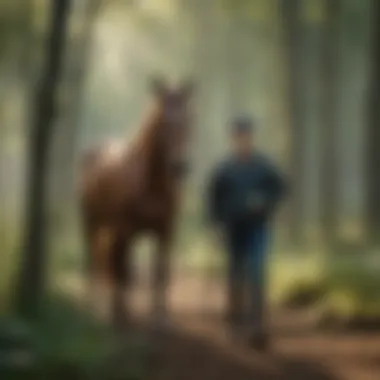
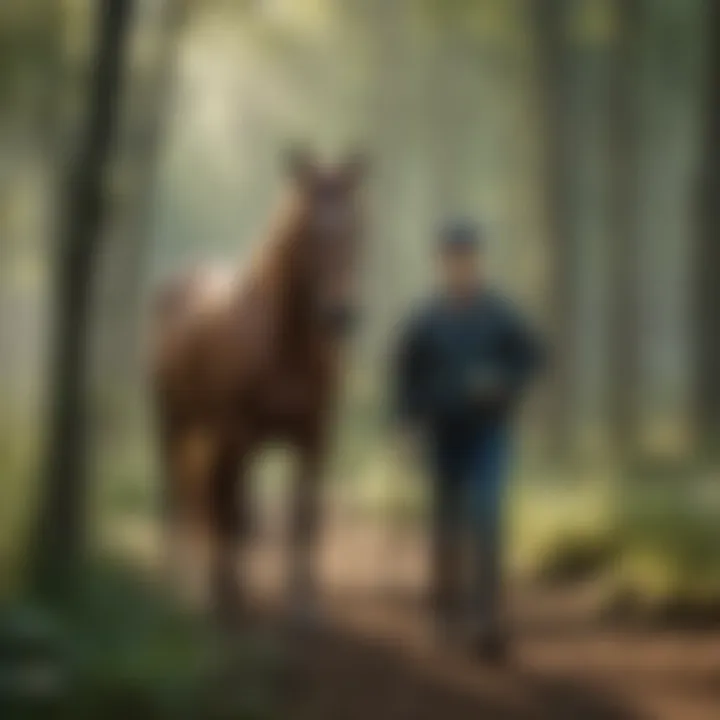
"Keeping a vigilant eye on pastures ensures that horse owners can adapt promptly to any changes in plant composition, safeguarding their animals from unexpected threats."
By implementing these preventive measures, horse owners can significantly diminish the exposure to toxic plants. This proactive approach not only protects the animals but also fosters a sense of responsibility and care in managing their well-being.
Management Strategies for Toxic Plants
Managing toxic plants is crucial for maintaining the health and safety of horses in various environments. Effective strategies can prevent toxic plant exposure, which can lead to serious health risks. Understanding these management techniques is important for horse owners, equestrians, and anyone involved in horse care.
Eradication Techniques
Eradication of toxic plants is essential for effective management. This can involve several methods:
- Mechanical Removal: Pulling out plants by hand or using tools can be effective but labor-intensive.
- Chemical Control: Herbicides can selectively target toxic plants while minimizing harm to desired vegetation. It is necessary to follow proper application instructions to avoid poisoning horses or damaging surrounding plants.
- Burning: In some cases, controlled burns can effectively eliminate toxic plants and prepare the land for healthier growth. This method should be practiced with caution due to potential risks.
It is vital to regularly monitor areas previously treated for regrowth. Horses should not be allowed to graze in these areas until all traces of toxic plants have been removed and enough time has passed for the land to recover.
Control through Grazing Management
Grazing management is another effective way to control toxic plant risks. This involves:
- Rotational Grazing: This technique allows specific areas to recover while directing horses to safer pastures. By shifting grazing locations, you can reduce the likelihood of horses consuming toxic plants.
- Proper Stocking Rates: Ensuring that there are not too many horses in one area can prevent overgrazing and reduce the chances of horses eating unfamiliar or potentially toxic forage.
- Regular Inspections: Periodically inspect pastures for any signs of toxic plants. Early detection can help reduce the spread and eliminate risks quickly.
By integrating these strategies into a comprehensive management plan, horse owners can ensure a safer environment. Preventing horses from accessing toxic plants is not just a matter of vigilance but requires ongoing commitment to pasture management and education.
"A proactive approach to managing toxic plants significantly reduces risk and enhances the wellbeing of horses in managed environments."
Effective management not only protects horses but also promotes overall pasture health and sustainability.
Educating Others About Toxic Plants
Educating others about toxic plants is a crucial part of ensuring the safety and well-being of horses. Understanding which plants are harmful and how to manage them can prevent serious health issues. The benefits of education extend beyond individual horse owners; it fosters a community approach to problem-solving. This information is essential for equestrians, stable managers, and even local communities where horses are prevalent.
When people are educated about toxic plants, they are more likely to take proactive measures. This includes recognizing dangerous species and understanding symptoms of poisoning. An informed community can also help in monitoring local ecosystems for these plants, thus preserving the health of horses throughout the region. Recognizing that information sharing can reduce risks is vital for effective preventive strategies.
Conducting Workshops
Conducting workshops is an effective way to spread knowledge about toxic plants. These sessions provide a platform for sharing practical information and hands-on learning. Topics can range from identification techniques to understanding the effects of plant toxicity on horses. Workshops can foster direct interaction between experts and participants, enhancing understanding and retention of important information.
Some key components of successful workshops include:
- Visual Aids: Using pictures of toxic plants to enhance identification skills.
- Live Demonstrations: Showcasing the correct methods for safe plant removal.
- Expert Speakers: Inviting veterinarians and ecologists to share insights increases credibility and interest.
Workshops can also create a network of horse owners and equestrians who can support each other in addressing plant toxicity issues.
Sharing Information within Communities
Sharing information within communities is equally important. Disseminating knowledge through social media, local groups, and newsletters ensures that a broader audience is informed. For instance, a Facebook group dedicated to local equine health can serve as an interactive platform for sharing discoveries about toxic plants.
Key strategies for effective information sharing include:
- Creating Informative Posts: Share facts about specific toxic plants and their effects on horses.
- Organizing Community Meetings: Facilitate discussions about local flora and its potential dangers.
- Collaborating with Local Veterinary Clinics: Clinics can distribute pamphlets or provide talks about plant toxicity.
Community involvement leads to a better-managed environment for horses, reducing the chances of exposure to harmful plants. Engaging various stakeholders not only promotes awareness but also encourages collective action towards maintaining safe habitats.
The End
Summary of Key Points
In summary, the article has explored numerous facets of toxic plants and their implications for horse health. The following key points are essential:
- Importance of Awareness: Recognizing toxic plants is essential for preventing accidental ingestion by horses.
- Characteristics of Toxic Plants: Understanding their general traits and variability in toxicity helps in identification efforts.
- Common Toxic Plants: Familiarity with both well-known and lesser-known species can help in managing horse environments effectively.
- Identification Techniques: Implementing visual identification and utilizing available resources can aid in recognizing dangerous plants.
- Effects on Health: Awareness of symptoms related to poisoning and long-term health implications assists in seeking timely medical assistance.
- Preventive Measures: Creating safe spaces and monitoring plant growth reduce the risks of poison exposure.
- Management Strategies: Effective eradication and grazing management are pivotal in controlling the presence of toxic species.
- Community Education: Conducting workshops and sharing knowledge creates a more informed community about plant toxicity.
Call to Action for Safety
In light of the information presented, it is imperative that horse owners and equestrians take proactive steps to ensure the safety of their animals. Here are several actionable recommendations:
- Educate Yourself and Others: Attend workshops and read materials on toxic plants. Knowledge is a strong first line of defense.
- Regularly Inspect Pastures: Make it a habit to walk through grazing areas to identify and remove toxic plants before they pose a threat.
- Engage with the Community: Share your findings and create discussions about toxic plants with fellow horse owners or local equestrian groups.
- Report and Share Findings: If you come across new information about toxic plants, share it on social media platforms or forums such as Reddit or Facebook to raise awareness.
- Stay Consistent: Awareness is an ongoing process. Regularly educate yourself about new research and findings related to equine toxicity.
Adopting these strategies will foster a safer environment for horses while ensuring their health and well-being is prioritized. Understanding toxic plants is not just a precaution; it is an obligation that comes with caring for these remarkable animals.







